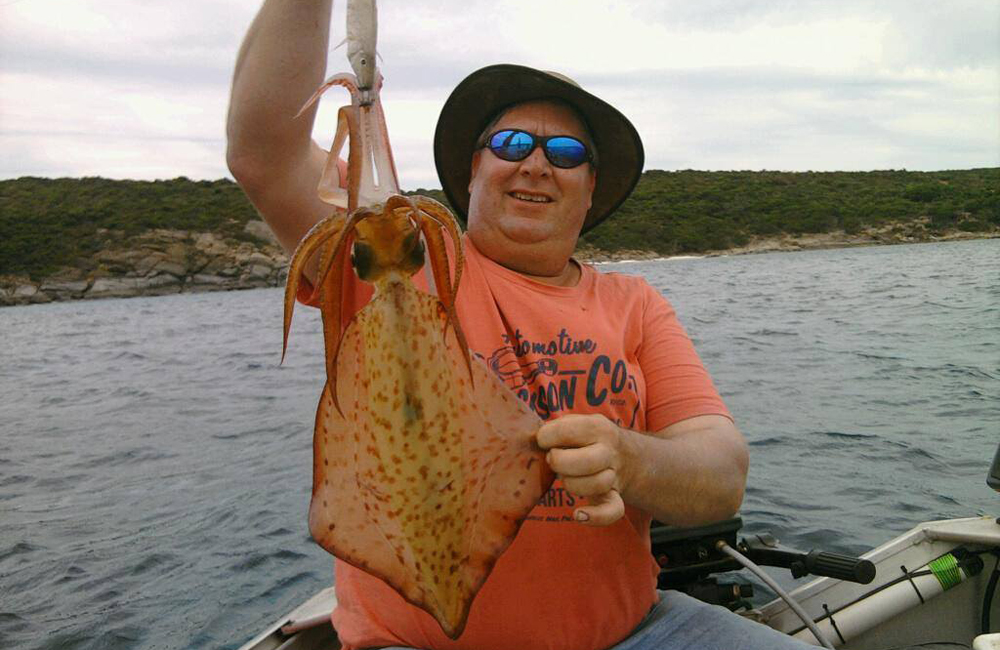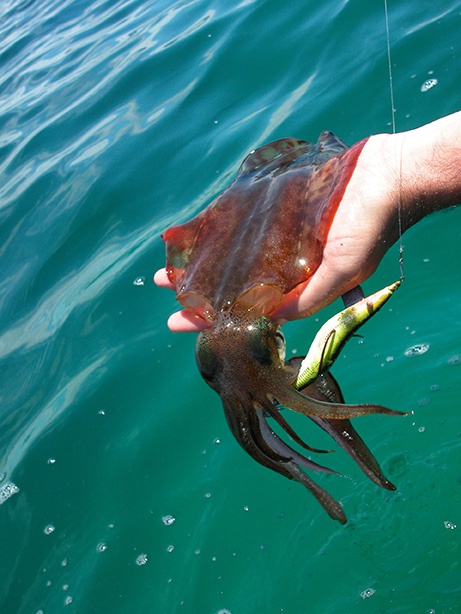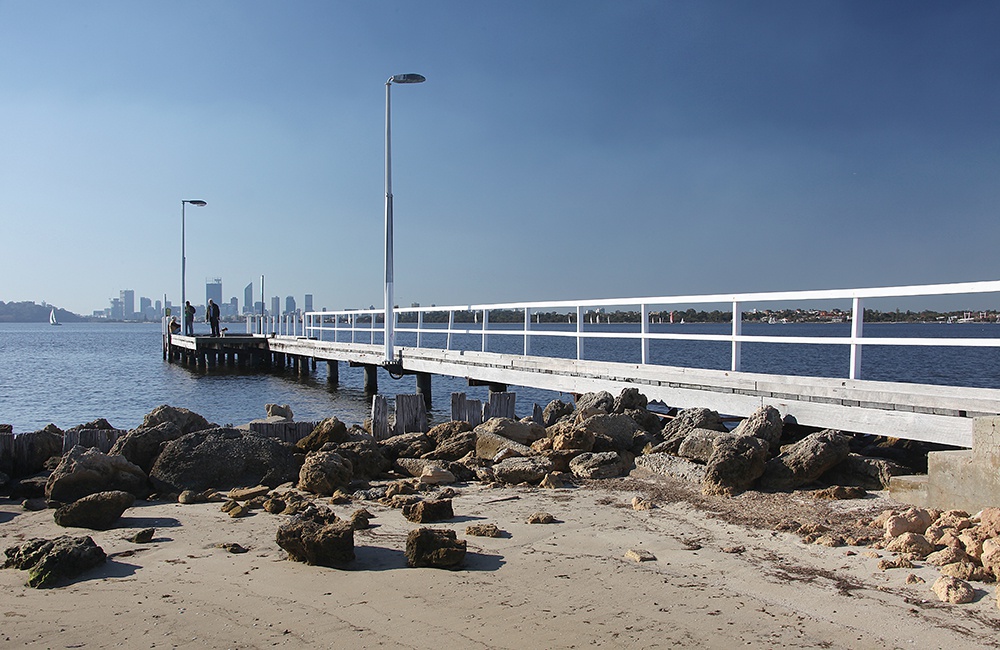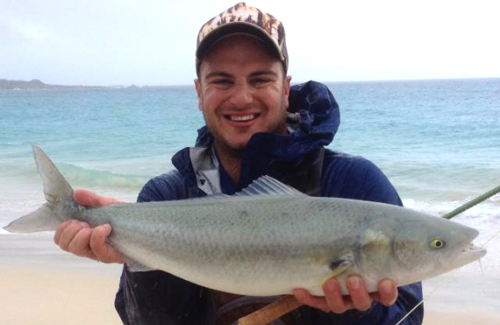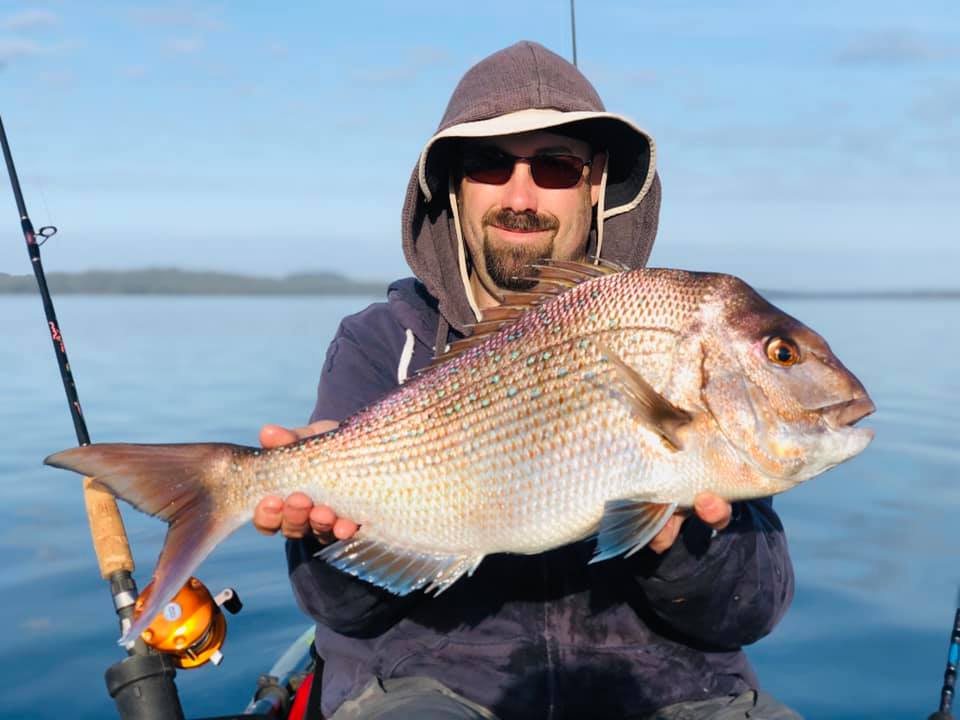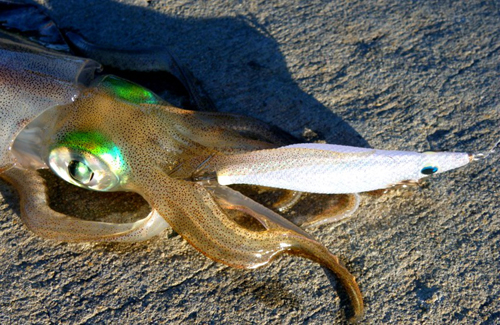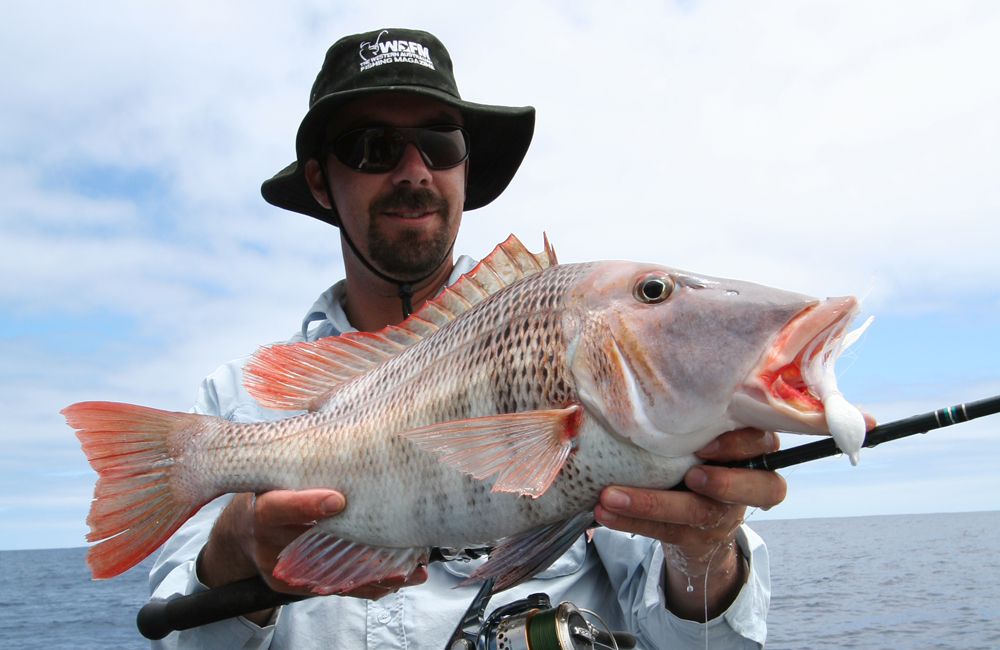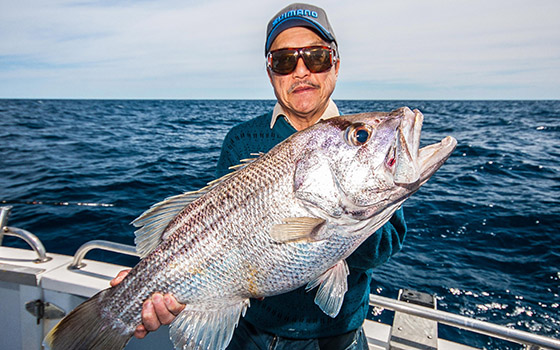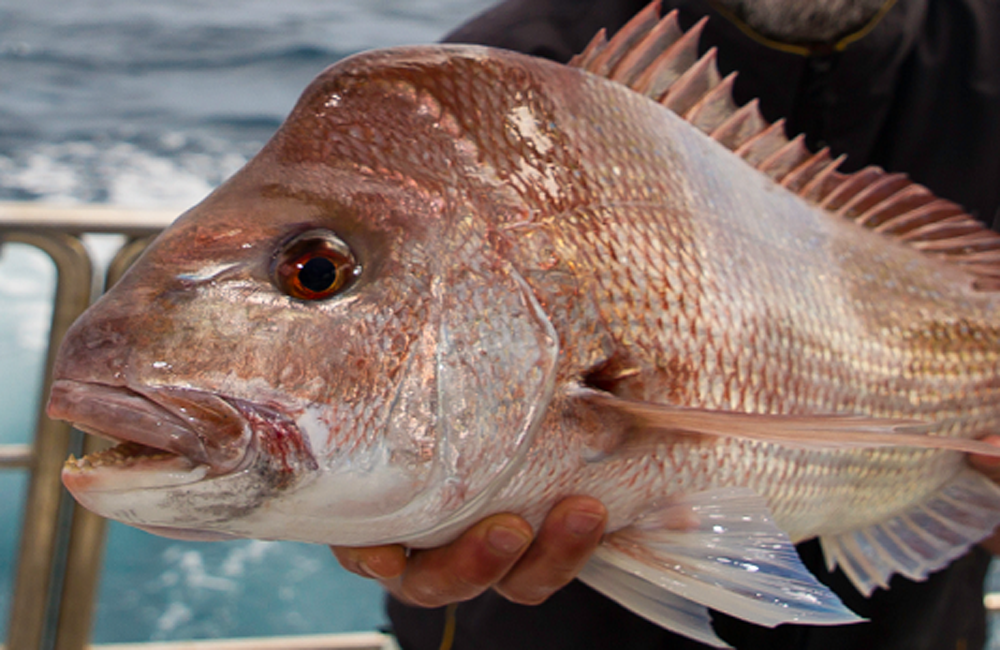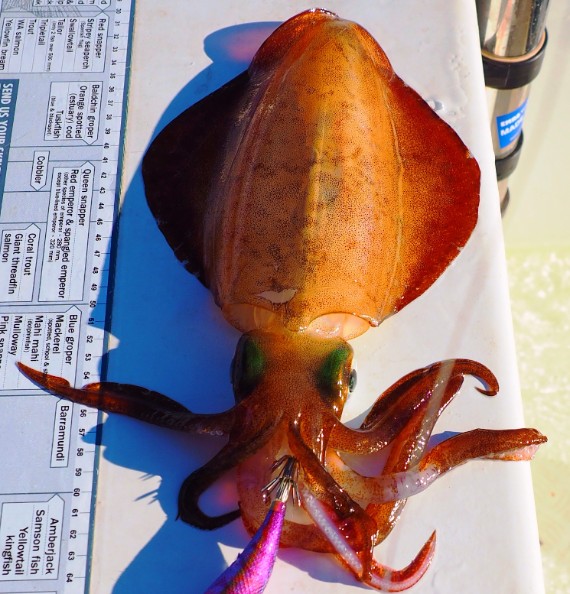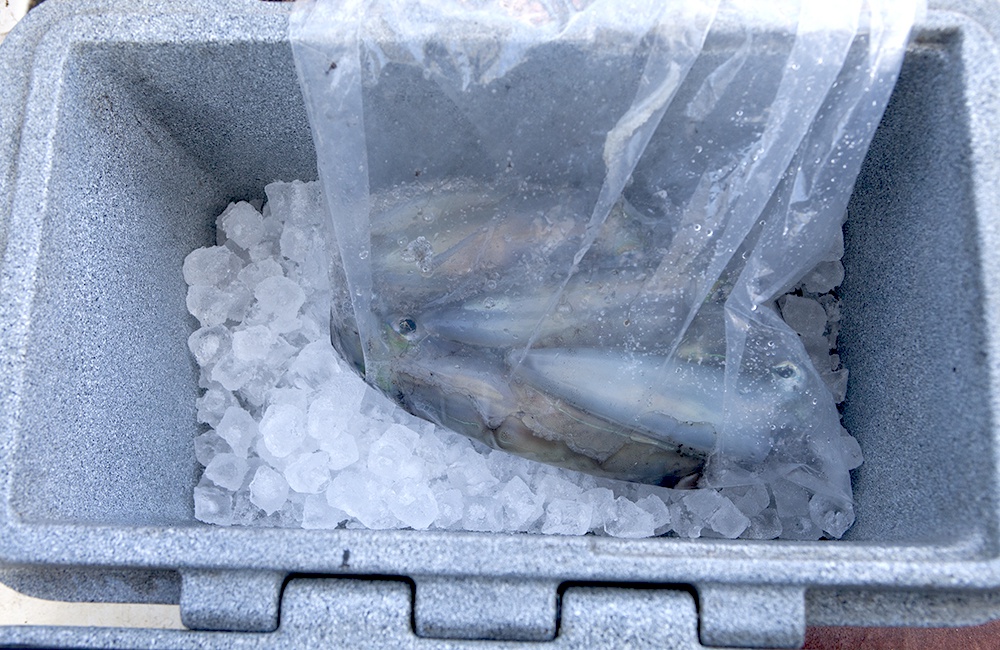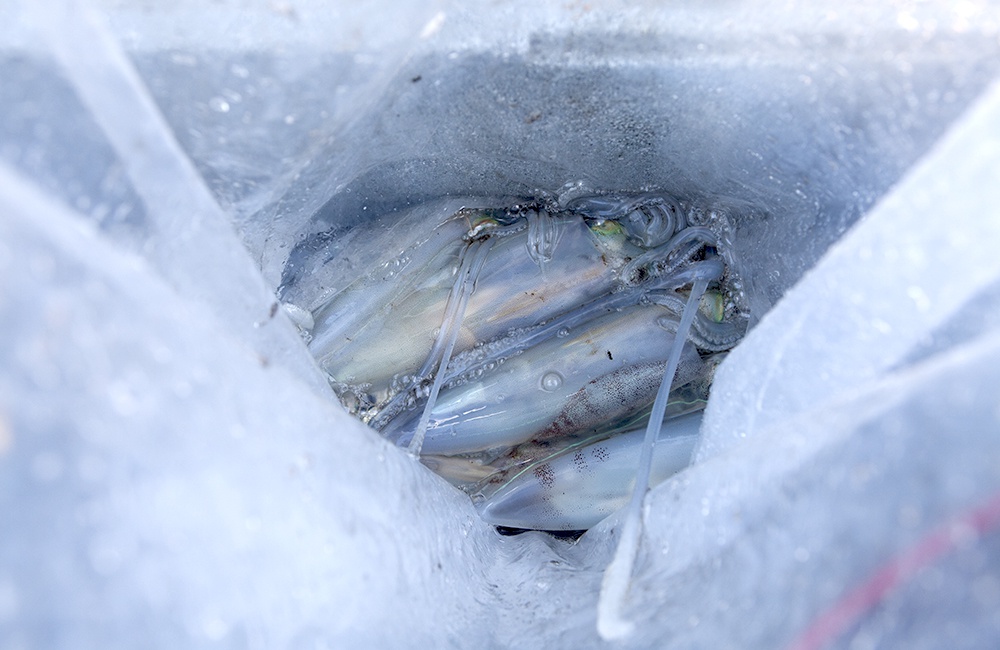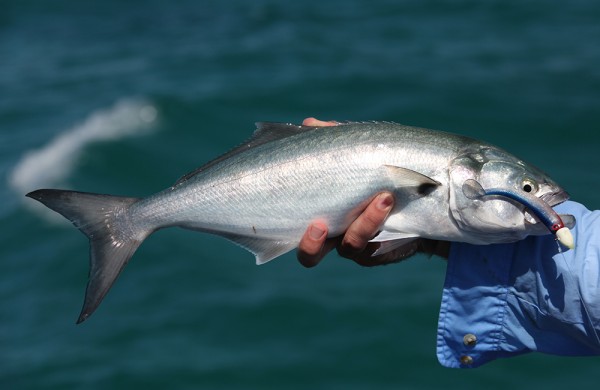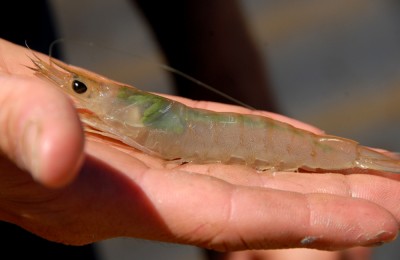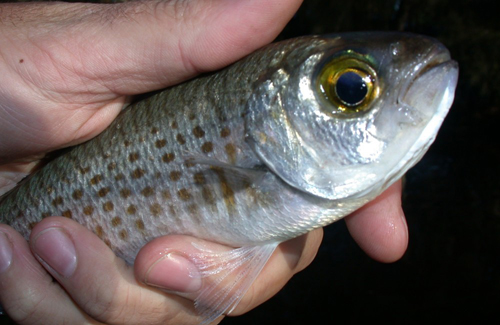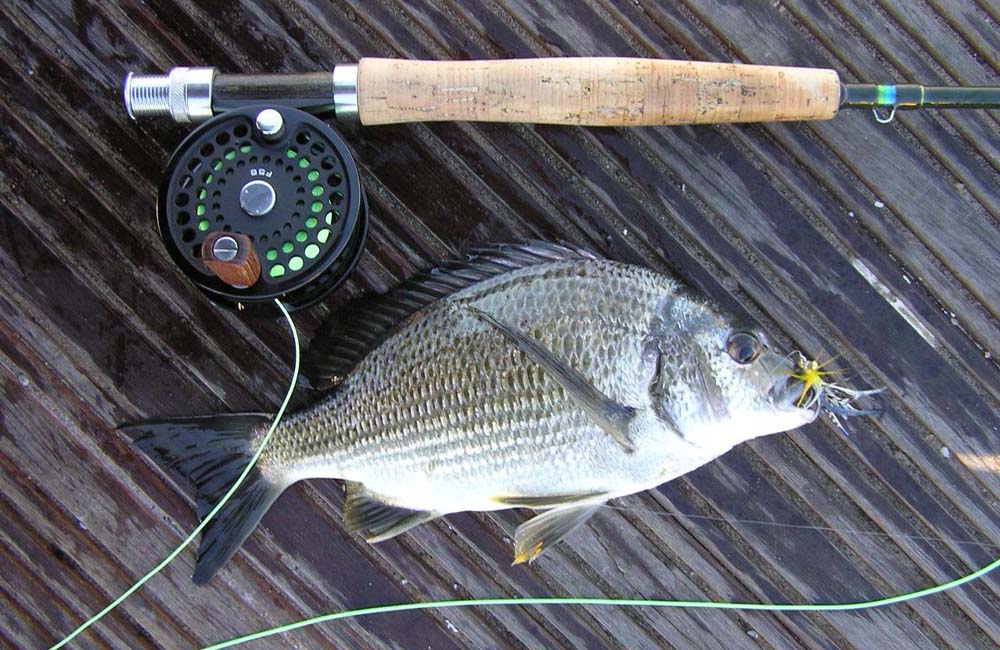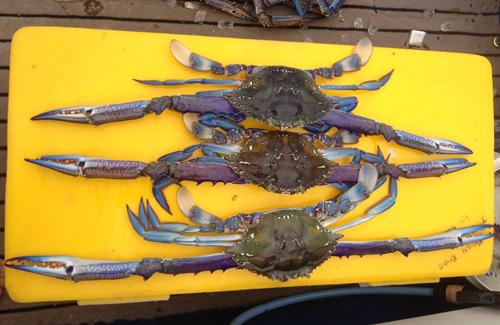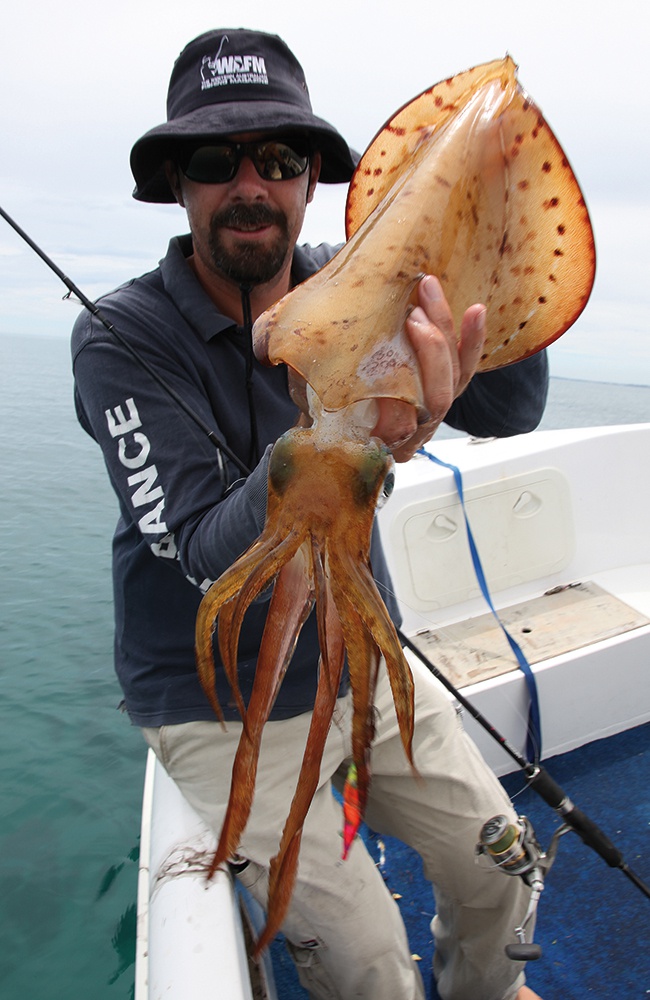
HOW TO CATCH SQUID
Squid fishing is fun for any age and is an absolutely great way to get younger kids into the fantastic out door sport that is fishing.
The most common method for catching squid from a boat is to find a likely looking seagrass bed and drift across it with a couple of squid jigs trailing out the back of the boat. When a squid grabs a hold of the jig the rod bends over or the handline starts spinning and bouncing on the deck, the squid is then brought to the boat with a very steady retrieve so as to not break off the tentacles.
From shore the most common method is to suspend a squid jig under a float, cast it out and wait for the float to be pulled under the surface or for the rod to bend. The squid is then wound in with steady pressure.
These methods have worked well in the past and will continue to work well into the future.
Tackle
The Japanese squid tournament scene has turned squid fishing into a major sport with big money up for grabs and has brought about massive developments in squid fishing tackle. Specialised squid rods have been developed for boat and shore fishing and squid specific lines are also being manufactured in PE and fluorocarbon. On top of this there are a myriad of accessories from squid jig cases and squid iki jimi spikes to telescopic squid gaffs for shore and jetty based anglers right down to specialised shoes.
A lot of this gear we may never see land on our shores, but already there are quite a few of the rods available in tackle stores. The top of the line rods can reach into the thousand dollar mark in Japan while most found here in Australia are in the more affordable price range, or at least are a lot less than this.
The specialised squid rods have quite a slow action but are made from high modulous graphite so are still able to belt even quite a small squid jig a long way. Having a soft action ensures that the tentacles will not be snapped off from too much pressure when fighting the squid. So if you are looking for a squid rod, especially for fishing from shore, these are worth at least having a look at.
If a dedicated squid rod sounds a bit extreme then find a rod that is reasonably slow in action and able to handle about four kilo line. For shore based rocks go for a longer rod up to about eight to nine feet. For jetty or boat fishing, around the six to seven feet mark should do the job. Once again rated to about four kilo will be plenty.
If you are fishing with braided line a fluorocarbon leader is not a must but certainly does seem to make a bit of a difference, especially when the squid are not aggressive and when the water is super clear and the sun is out. If you do not use fluorocarbon at least use a light mono leader in a light pink or clear colour.
Squid jigs
When it comes to squid jigs or lures many people tend to get a bit daunted. In recent years the variation on types and colours has become endless, mostly due to the aformentioned Japanese squid tournament scene.
For most squid anglers, there is only the prawn type jig. They come in a myriad of different sizes, styles and colours. Inside this range there is also a massive variation in prices. They can start at as little as five dollars a piece and can go up to about the forty dollar mark. Many recommend only looking at the ones from twenty dollars upwards. Often the cheapies out fish the expensive ones on certain days, but on the most part, the more expensive ones seem to last longer and catch more squid.
The size of the squid jig can be quite critical, especially if the squid are small or are being quite timid. If the squid are being timid it pays to be less aggressive than suggested later on in this article and to switch down to a smaller jig in the 2.0 to 2.5 size range.
If the average size of the squid is big then put on the biggest jig you have and you will generally only catch bigger squid. For most of the year however a jig in the 3.0 size range should get you a fair catch of squid.
Colours are probably the biggest point of confusion for most when squidding. Most people have a favourite colour and that is all they will use come rain, hail or shine. The only reason it is their favourite is because they had a cracking session on that colour one time in the past.
When it comes to all of the other colour combinations available out there now, I advise you to just give them a go and see what happens. When you are not catching and you know they should be there it’s the time to start changing colours until you find one that works.
While on squid jigs there are a couple of things you can do to squid jigs to fine tune them a bit. The biggest problem encountered is that the squid might be taking a 3.0 squid jig hand over fist but the wind picks up and speeds up the drift so that it can not get down as far in time. Your first option is to put out a sea anchor. If you have already done this and you have one of the tournament style jigs, which can be dentified by the hole through the keel weight, use some solder wire or lead wire to wind through the hole and around the jig to allow it to get to the desired depth as needed. It is actually what the hole is for, it is just hard to read on the Japanese packaging.
Tactics
When it comes to the retrieve there is no clear cut rule as most techniques will produce a squid or two. In Japan, ripping a jig a couple of metres through the water in one whip of the rod is pretty much considered standard fare, however the critical part of the Japanese tecnique is when the jig is falling back down to the bottom. This is generally when the squid grabs the jig, so they put a lot of concentration into watching the line for any movement as a squid tries to make off with the lure. Once this is spotted the jig is set with a firm strike and then fought into the net.
Another point worth mentioning about the Japanese tecnique is that they don’t move the jig at all while it is falling. The only time the jig is moved is when it is being ripped away from the approaching bottom to get the squid’s attention or to set the hooks on a squid that has already taken the jig.
While it might take a hell of a lot of will power not to move the jig too often, the Japanese style of jigging for squid is certainly a system that works very effectively on our southern calamari, no matter where you fish.
Once you catch your squid it is best to look after them properly so that they taste their best. Check out the Catch Care and Cooking tab to find out how to ensure you get tender squid every time.
The Secret to Tender Squid
Like most table-bound creatures from the sea, squid will always taste better if it’s killed humanely by a method called iki jime. Learn this method and enjoy tasty, tender seafood every time.
Click on the Catch Care and Cooking tab on this page to view our squid iki jime video and learn how it’s done.
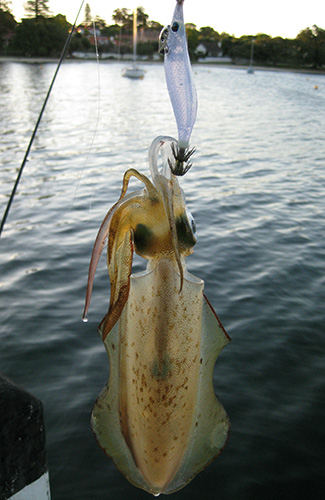
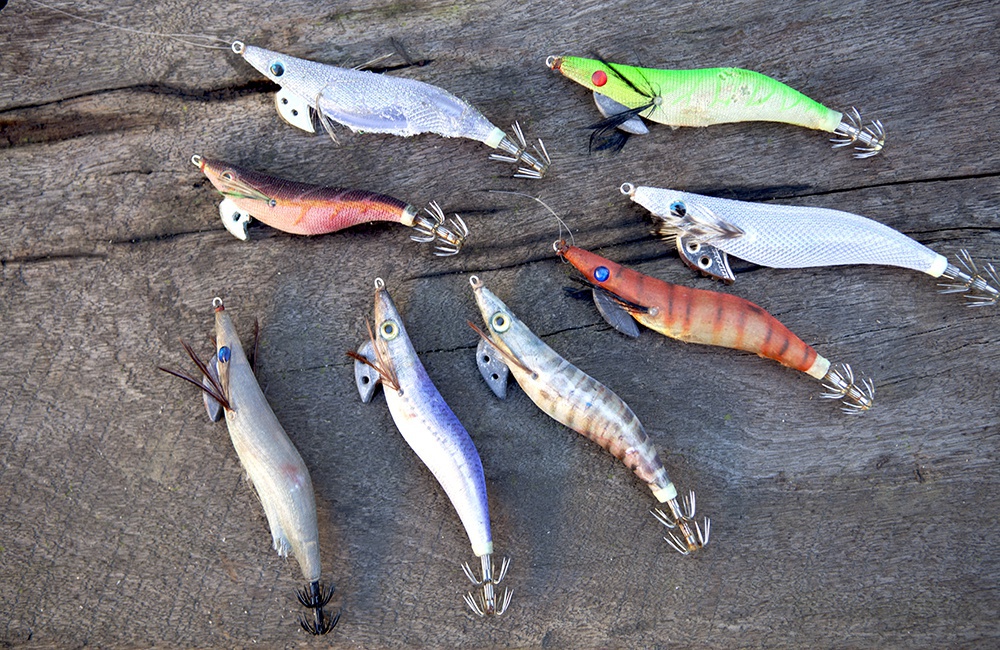
Squid Jig Selection
If you ask 20 people what their favourite colour of squid jig is you can almost be sure you will get 20 different answers.
So to help ease the confusion before you get started on your squid fishing journey here is a bit of a guide to squid jig colour selection.
When the cloth type squid jigs first came into Australia, they were pretty limited in colours, so making a colour selection was once very easy. These days, if you have a look on any tackle shop wall at the squid jigs available, the colours are almost endless. To make matters even harder, every tackle shop will have a different selection of colours.
While most squid chasers know that on different days different colours work better than others, it is not usually the colour you see that makes the biggest difference. If you look closely at a squid jig you will notice that, while it has a particular colour or pattern on the cloth coating, you will see that under the cloth covering there is another colour shining through. These under colours or foil coatings are usually metallic in appearance and vary between a few core colours.
If you ask the lure manufacturers, this is the part of the jig design that matters the most as it is the part that gets the squid’s attention initially. After that, the jig looks like a prawn and they presume that the squid will have a go at it.
Internal colours
The base or foil colour can be any one of usually six colours; gold, silver, red, rainbow, glow and clear.
Gold is considered a pretty much all round colour that can be used in any water clarity and time of day but is said to excel first thing in the morning.
Silver is another good option particularly in clear water conditions.
Red is a good option for night time squidding.
Rainbow for cloudy conditions.
Glow is best for overcast low light and night.
Clear is best for bright sunshine and clear water.
External colours
When choosing external colours the general rule of thumb is that the brighter/lighter the conditions and the clearer the water, the more natural the colours. For dirty water, brighter colours will work best.
While it is not written in stone and it may not be one hundred percent effective all of the time, the squid jig colour rule of thumb goes like this:
Green is for clear water and cloudy conditions.
Blue is for clear water and clear conditions.
Orange is best when the water clarity is down.
Pink squid jigs are probably the most used by squid fishers and as such catch a lot of squid. Pink is considered by many to be the preferred fall back colour when others are not working.
While it might seem confusing at first, after a bit of time you will soon have your favourite jig to use in a given situation. Just remember if you are not catching, change colours and base colours until you find one that works.
What is written above is just a guide to get you started. Get some jigs, catch some squid with family and friends and most of all have some fun.
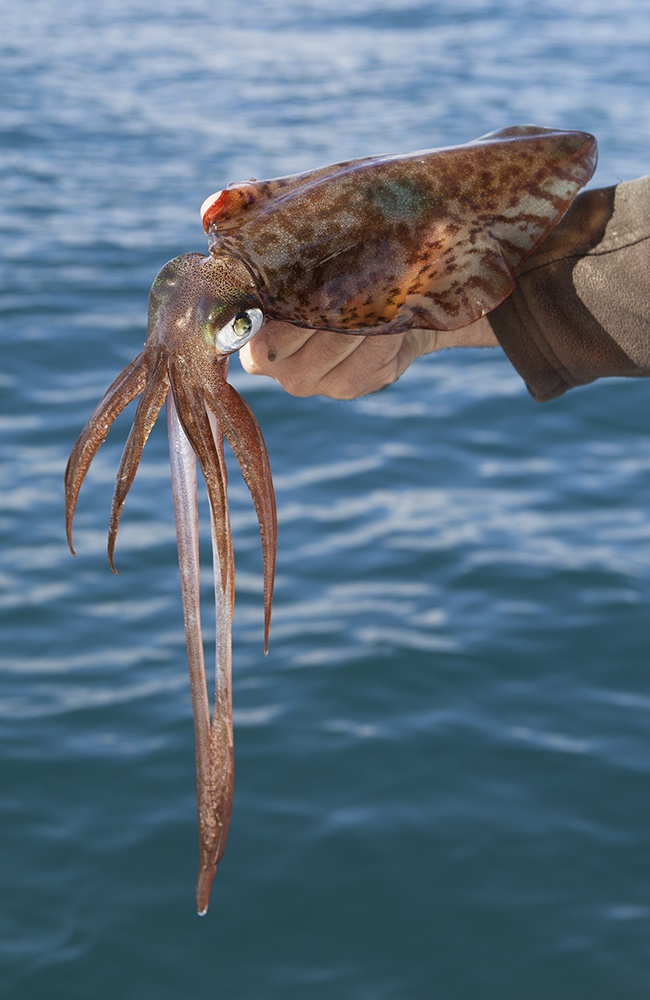
Habitat and Distribution
The southern calamari can be found from the WA border in the south all the way up to Dampier in the Pilbara.
Squid will live in many varied locations. Sea grass beds are the most common places for anglers to chase them, however they can also be found around reef, kelp beds, even in open water over a sandy bottom and man made structures such as navigation poles or jetties. They can live in shallows of less than a metre of water out to over forty metres of water. Squid can also inhabit the lower reaches or more saline parts of estuaries and rivers. They are found close to the bottom during the day and closer to the surface at night when they feed more actively.
The bottom line is, squid can and do live anywhere. Their varied habitat is one of the reasons why they are such a sought after species by anglers. Whether you are fishing from a jetty, the rocks or the beach or have a small tinny or a big launch, you can catch squid.
Where to Catch
Increase your chances of catching!
Before heading out, find out where the fish are biting throughout Western Australia in our Weekly Fishing Forecast.Other names
Sepioteuthis australis, calamari, southern calamari, calamari squid and southern squid.
Description
Cephalopods take in a small group of marine creatures which include the octopus, cuttlefish, nautilus and the one we are interested in, the squid. The particular squid that is most common in Western Australian waters and the one we will be focusing on is the southern calamari or scientific name Sepioteuthis australis.
Cephalopods, squid, calamari, call them what you like. Squid and calamari are actually the same thing. Calamari is usually what a squid is called once it is cooked, probably because it sounds more exotic on the menu than squid.
Squid are amazing creatures. They can change colours in the blink of an eye and format these colours into any assortment of patterns to hide their presence from predators. They have the ability to squirt out a cloud of jet black ink which they can either hide in to evade predators or use it as a screen to make a hasty escape.
Probably the most incredible fact about the southern calamari is their life span. They live to about 12 to 18 months old and can reach a size of fifty centimetres in mantle (tube) length, however they are mostly caught at around twenty centimetres. Their relatively short life span means they lay their eggs in quite large numbers to ensure the continuation of the species. It is this that puts squid at a low risk of ever being fished out.
Identification
The only species that might be mistaken for a squid is its cousin the cuttlefish, but squid can be distinguished by the diamond shape to their body that is created by the fins that run around the entire body and the nearly transparent appearance of the body with its transparent pen, as opposed to the more opaque body of the cuttlefish with its cuttlebone. Squid have eight tentacles as well as two extendable feeding tentacles that have suckers for grasping prey. Colours range from yellow-green to orange and even purple.
Squid iki jime:
How to Clean Squid:
Rules and Regulations
There are usually no size restrictions on squid however there is a squid, cuttlefish and octopus combined bag limit and boat limit. The 2016 combined daily bag limit for these species is 15 and the combined daily boat limit is 30. Current information can be found in the Recfishwest App.
Squid are great fun to catch and are usually a favourite with the kids. They are also great to eat and make good bait.
When chasing squid it is always wise to have a system in place that keeps them in top condition, especially if you are intending to eat your catch.
Of highest importance is an esky and some ice. Keeping squid icy cold is very important as their delicate flesh starts to break down very rapidly once they die.
Next on the list is a large plastic bag. Once you catch a squid and get it onto the boat or shore, it is wise to place it into a plastic bag and then put the plastic bag onto your ice in the esky. This prevents the squid from unleashing a torrent of black ink all through your esky and ice. If you have any crustaceans or fish mixed in with the black ink in the esky it will affect their flesh and how they taste. Using the bag will also save the cleanup once the day is done. It is best to avoid scented garbage bags for this task.
The next thing to think about is how you are going to humanely kill the ones you wish to keep. Gaining more acceptance and popularity is the process called squid iki jime. This basically involves using a half moon shaped blade on the end of a spike to kill the squid. It takes two incisions to do it properly. First, the iki jime tool is pushed through the section just behind the eyes on an angle towards the back of the squid. This instantly makes the tube turn white. The tool is then taken out and pushed straight down between the eyes making the tentacles turn white. This process is best performed as soon as the squid is caught. They can then be placed into your plastic bag and straight onto the ice. Check out our Squid Iki Jime video to learn how it’s done.
You can make a squid iki jime tool from an old stainless knife or you can buy the purpose made tool from your local tackle shop. On the bought model there is also a handy little tube on the side for straightening bent squid jig barbs.
Purpose made squid iki jime tools are relatively inexpensive and are available from most tackle shops.
Using the squid iki jime method is said to improve the eating quality of the squid and also allows them to be dealt with and put into the esky without the surprise of a stream of black ink going everywhere.
When you get home
Once home, the squid can be removed from the ice and cleaned.
Leaving the squid on ice for about 24 hours will make the cleaning process a lot easier as the skin and wings become easier to remove.
The clean tubes are frozen and thawed at a later date for eating. Freezing squid before eating is known to help tenderise the meat which makes them less chewy.
The tentacles can be bagged up to use as bait for future fishing trips, however if you prefer they can also be eaten.

